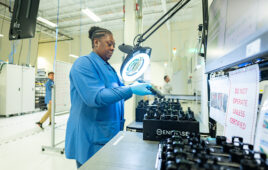When it comes to decarbonization, we’re pointed in the right direction. The United States has set ambitious targets to achieve 100% carbon pollution-free electricity and establish a net-zero emissions economy by 2035. However, the energy transition’s success depends on ensuring that all Americans, regardless of location or socioeconomic status, can participate in this pivotal shift. Tax credits and rebates from the Inflation Reduction Act (IRA) have helped reduce the cost of home electrification and electric vehicle (EV) ownership, but significant roadblocks remain.
Cleantech has traditionally been expensive and early adopters of clean energy technologies such as solar, batteries and EVs came from wealthier segments of society. But as we aim to progress beyond the early adoption phase and into mass electrification, we must enable participation from all socioeconomic groups. Otherwise, we’ll fail to achieve our climate goals in time.
Utilities and policymakers should focus on two central themes when working towards energy equity:
- Scale: Achieving our electrification and carbon reduction goals will require mass participation
- Fairness: Incentive programs should ensure that all stakeholders benefit, not just the wealthy.
Unfortunately, there is a disconnect between the cost of clean energy adoption and the average American income. In 2020, households with residential solar systems had a median income of about $115,000 per year, while the median household income was only about $63,000 annually. This disparity increases for those below the median income — a group largely excluded from the clean energy market. Moreover, 65% of low-income families bear the burden of inefficient home energy systems and don’t receive their fair share of utility energy-efficiency funds.
We must bring affordable clean energy access to the forefront to achieve our clean energy goals and alleviate the disproportionate energy burden underserved communities face. The federal government acknowledges this need and aims to deliver 40% of the benefits from its climate and clean energy investments to these communities. Energy equity is critical when prioritizing solutions for electric ratepayers across all income levels — aiming to improve the health, safety and energy resilience of communities disproportionately impacted by the negative effect of fossil fuels. Ensuring access to affordable clean energy for all will generate collective benefits as we navigate the energy transition.
Weighing energy burden
When discussing the energy transition, the percentage of income spent on home energy bills — the household energy burden — is an essential factor to consider. Any value above 6% indicates a high energy burden. Certain minority groups, seniors, renters and low-income multifamily building residents bear disproportionately higher energy burdens at 8.1% versus the median household at 3.1%. This increased expense includes higher costs for homes that have inadequate insulation, less efficient appliances and rely on bottled fuels like oil and propane.
While these homes have a higher potential for cost savings through energy bill reduction programs, economic disparities in access to these programs persist. The American Council for an Energy-Efficient Economy (ACEEE) found that while roughly 28% of U.S. households classify as low-income, they receive only 13% of the spending from electric and gas utility energy-efficiency programs. For the energy transition to advance, we must make a more significant effort to connect those needing assistance with equitable funding.
Enabling adoption
Solutions are underway, with the U.S. government launching various funding and education programs for homeowners and renters. The Office of Economic Impact and Diversity is expanding energy programs in underserved communities, using an Energy Affordability Resource Map to connect homeowners and renters with assistance programs. Additionally, the U.S. Department of Energy has initiated a $3 billion partial loan guarantee program in partnership with solar and storage provider Sunnova. This program aims to enhance clean energy access and capacity in underserved communities by lowering loan interest rates and making rooftop solar and storage systems more affordable for lower-income customers.
The recently enacted High-Efficiency Electric Home Rebate Act (HEEHRA) under the Inflation Reduction Act (IRA) further supports low- and moderate-income households by offering point-of-sale rebates for qualified electrification projects. For instance, households can receive up to $6,500 in HEEHRA rebates for installing an energy management system, $4,000 for upgrading electrical panels, including smart panels, and $2,500 for electrical work.
Although various income ranges embrace solar adoption, the difference between home ownership and the concentration of residential solar adoption is a well-documented disparity. The Office of Energy Efficiency & Renewable Energy (EERE) is implementing programs to expand access to clean energy through top-down equity and environmental justice initiatives, including broadening engagement with community-based organizations, tribal nations, states, local governments and minority-serving institutions. It’s also collecting more data, expanding funding opportunities, and advancing equity-focused research.
Advancing clean energy equity
The good news is that these programs are working — studies show that disparities in clean energy adoption are decreasing. Between 2010 and 2020, the median income of solar adopters fell from $138,000 to $115,000. This trend may continue as solar becomes more affordable for low- and middle-income households.
One national research lab predicts low-to-moderate income rooftop solar could contribute 42% of residential solar energy in the future. Additionally, community solar projects have helped increase access to clean energy in underserved communities where rooftop solar is not as viable.
As the country strives to achieve its decarbonization goals, it is imperative that we actively seek solutions to ensure a broad-based and equitable transition. We need innovations that overcome barriers to mass electrification, initiatives that foster access to clean energy and measures that alleviate the energy burden. Failing to address these challenges risks stifling the energy transition by excluding millions of homeowners from its benefits. To achieve our decarbonization goals, it is incumbent upon utilities, government agencies, cleantech providers and investors to collectively step forward and embrace this mission. Now is the time to seize this opportunity and propel our nation toward a sustainable and equitable energy future.
With more than three decades of energy industry experience, Kelly Warner brings extensive knowledge to the Lumin team. Most recently, he served as president and founding board member of energy storage pioneer Advanced Microgrid Solutions (AMS), where he led technology development, finance, strategy and business operations. Before that, he spent 15 years in various CEO roles with Deerpath Energy, a micro-wind energy company he founded, and energy consulting firms XENERGY and KEMA. As CEO of XENERGY, Warner led the company to become the first to sell competitive electricity to retail customers on the East Coast. A recognized leader in utility industry restructuring, Warner started his career in solar and became a national expert in energy efficiency and demand-side management. Warner holds an M.S. in civil engineering from Stanford University and a B.A. in American studies from Williams College.





Words of wisdom from one of my how to save the planet mentors! Thank you Kelly Warner